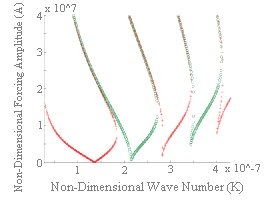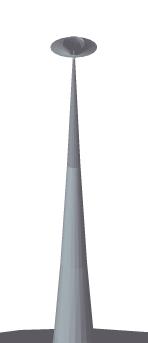
Brad Forrest
Research
Brad Forrest
 Harvey
Mudd College Mathematics
and Physics Class of 2002
Harvey
Mudd College Mathematics
and Physics Class of 2002
Presently at Cornell University, Mathematics Graduate Student
Thesis: Modeling Faraday Excitation of a Viscous Fluid(in pdf)
Advisor: Professor Andrew J. Bernoff
Awards:
- Graduated with High Distinction
- Graduated with Honors in Mathematics
- 1998-99 Chemical Rubber Company Award Winner
Ciriculum Vitae: Forrest_CV.html
Modeling Droplet Ejection with Faraday Excitation
Previous research has shown that the size of an ejected droplet is determined by the wavelength of the surface that ejects it.[1-3] There is in fact a universal constant factor that relates the diameter of a droplet to the wavelength of the surface wave that ejected that droplet. Currently, Professor Tom Donnellyís particle sizing research group (HMC Physics) is generating droplets through the Faraday mechanism, and precisely measuring the size of these droplets through MIE scattering techniques. The goal of my research has been to provide the Donnelly research group with predictions for the wavelength of the surface waves generated by Faraday Excitation on any fluid with any set of values for the oscillation amplitude and oscillation frequency of the forcing vibration.
I used linear stability analysis to the Faraday Excitation model as
my main method of analysis of this problem. My analysis is similar
to that used by Kumar and Tuckerman in 1994.[4]
In their work, Kumar and Tuckerman generated neutral stability curves for
a system of two fully viscous fluids subjected to Faraday Excitation.
These stability curves predict the regions of parameter space for which
unstable surface waves, surface
waves that grow without bound, can occur. Since only growing
fluid surface waves can eject droplets, this analysis predicts the conditions
under which droplets will form for the two fluid problem.
If in the experimental setting, the amplitude of the oscillator is slowly increased until droplets are observed, this exclusively selects the minimum amplitude unstable wave mode. In other words, the waves that are producing droplet ejection must correspond to the point on the neutral stability curve that is a minimum in amplitude.
I generated the neutral stability curves for a generalized fluid over a 25 decade range of forcing frequency. Figure 1 is the plot of the neutral stability curves at low frequency, while Figure 2 is a plot of the neutral stability curves at high frequency. I also produced a short animation (in mpg and avi formats) that shows how these neutral stability curves change qualitatively as the non-dimensional forcing frequency is increased from 10^-10 to 10^5.
Figure 3 is a log log plot of the surface wave number corresponding to the point of minimum oscillation amplitude vs. angular forcing frequency. The relationship depicted in this plot is the final prediction that was provided to the experimental research group. Note that there are two distinct scaling regimes, as two different slopes on exist in the figure. For low forcing frequency, surface tension is the dominant effect, while for high forcing frequency surface tension is dominated by viscosity.
For more information about this work, see my senior thesis. For information about the cited references, see my bibliography.
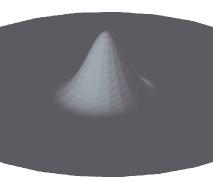
Animation 2: Qualitative depiction of how the neutral
stability curves for the Faraday Excitation system change as the non-dimensional
forcing frequency increases logarithmically from 10^-10 to 10^5 (in mpg
and
avi
formats.)
- Figure 1: Neutral stability curves for W
= 10^-10. Note that the red +'s indicate sub-harmonic solutions while
the green o's indicate harmonic solutions. Also note that the
x axis, K, is the non dimensional wave number and that the y-axis, A, is
the non dimensional forcing amplitude. They have been non dimensionalized
as follows:
W = w ( n^3 /(s/r)^2),
A = a ( (s/r)/ n^2 ), and
K = k ( n^2 / (s/r) ),
where
s is the fluid's surface tension,
r is the fluid's density,
n is the fluid's kinematic viscosity,
w is the dimensional angular forcing frequency,
a is the dimensional forcing amplitude, and
k is the dimensional surface wave number.
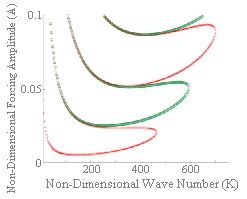
Figure 2: Neutral stability curves for W
= 10^5. Note that the red +'s indicate sub-harmonic solutions while
the green o's indicate harmonic solutions. Axes are the same as in
Figure 1.
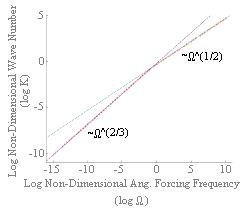
Figure 3: Log log plot of the wave number corresponding
to the minimum amplitude point on the neutral stability curves vs. angular
forcing amplitude. The axes are log W
on the x-axis and log K on the y-axis. Note the two distinct
scaling regimes. The blue line is the scaling for the surface tension
dominated low W regime, while the green line
approximates the viscosity dominated high W
regime.
For higher quality versions of any of these figures, click on the figure.
